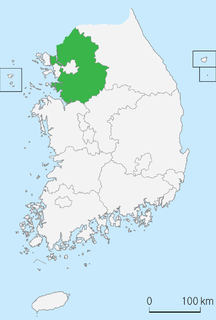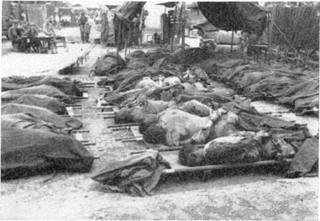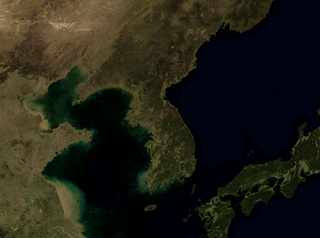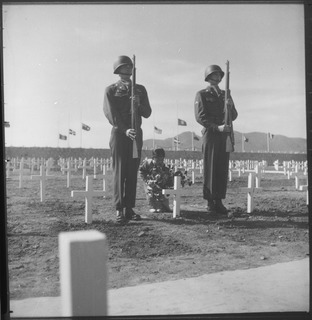 W
WThe Bodo League massacre was a massacre and war crime against communists and suspected sympathizers that occurred in the summer of 1950 during the Korean War. Estimates of the death toll vary. Historians and experts on the Korean War estimate that the full total ranges from at least 60,000–110,000 to 200,000. The massacre was wrongly blamed on the communists. The South Korean government made efforts to conceal this massacre for four decades. Survivors were forbidden by the government from revealing it, under suspicion of being communist sympathizers; whilst public revelation carried with it the threat of torture and death. During the 1990s and onwards, several corpses were excavated from mass graves, resulting in public awareness of the massacre.
The Chaplain–Medic massacre took place in the Korean War on July 16, 1950, on a mountain above the village of Tuman, South Korea. Thirty unarmed, critically wounded United States Army (US) soldiers and an unarmed chaplain were murdered by members of the Korean People's Army (KPA) during the Battle of Taejon.
 W
WThe Daejeon, or Taejon, massacre was an extrajudicial killings of political prisoners under anti-communist South Korean forces. US officers were present at the time of the slaughter, however it was blamed on the communist North Korean forces in the film Crime of Korea. Half a century later, the South Korean Truth and Reconciliation Commission investigated what happened in the political violence largely kept hidden from history, unlike the publicized North Korean executions of South Korean right-wingers.
 W
WThe First Battle of Seoul was the North Korean capture of the South Korean capital, Seoul at the start of the Korean War.
 W
WThe Goyang Geumjeong Cave massacre was a massacre of over 153 unarmed civilians conducted between 9 October 1950 and 31 October 1950 by police in Goyang, Gyeonggi-do district of South Korea. After the victory of the Second Battle of Seoul, South Korean authorities arrested and summarily executed several individuals along with their families on suspicion of sympathizing with North Korea. The killings in Goyang coincided with the Namyangju Massacre in nearby Namyangju.
 W
WThe Hangang Bridge bombing was a demolition operation conducted by the South Korean Army to destroy the Hangang Bridge in Seoul, South Korea, on 28 June 1950, to delay the rapid North Korean advance towards the city.
 W
WThe Hill 303 massacre was a war crime that took place during the opening days of the Korean War on August 17, 1950, on a hill above Waegwan, South Korea. Forty-one United States Army (US) prisoners of war were shot and killed by troops of the North Korean People's Army (NKPA) during one of the numerous smaller engagements of the Battle of Pusan Perimeter.
 W
WThe Namyangju massacre was a mass killing conducted by South Korean police and local militia forces between October 1950 and early 1951 in Namyangju, Gyeonggi-do district of South Korea. More than 460 people were summarily executed, including at least 23 children under the age of 10. After the victory of the Second Battle of Seoul, South Korean authorities arrested and summarily executed several individuals along with their families on suspicion of sympathizing with North Korea. During the massacre, South Korean Police conducted the Goyang Geumjeong Cave Massacre in Goyang near Namyangju. The killings in Namyangju coincided with a similar massacre committed in nearby Goyang.
 W
WThe No Gun Ri massacre occurred on July 26–29, 1950, early in the Korean War, when an undetermined number of South Korean refugees were killed in a U.S. air attack and by small- and heavy-weapons fire of the 7th Cavalry Regiment at a railroad bridge near the village of Nogeun-ri, 100 miles (160 km) southeast of Seoul. In 2005, a South Korean government inquest certified the names of 163 dead or missing and 55 wounded, and added that many other victims' names were not reported. The No Gun Ri Peace Foundation estimated in 2011 that 250–300 were killed, mostly women and children.
 W
WThe Seoul National University Hospital massacre was a massacre committed by the North Korea's Korean People's Army on 28 June 1950 of 700 to 900 doctors, nurses, inpatient civilians and wounded soldiers at the Seoul National University Hospital, Seoul district of South Korea. During the First Battle of Seoul, the KPA wiped out one platoon which guarded Seoul National University Hospital on 28 June 1950. They massacred medical personnel, inpatients and wounded soldiers. The Korean People's Army shot or buried the people alive. The civilian victims alone numbered 900. According to South Korean Ministry of National Defense, the victims included 100 wounded South Korean soldiers.
 W
WUnited Nations Security Council Resolution 82 was a measure adopted by the United Nations Security Council (UNSC) on June 25, 1950. The resolution demanded North Korea immediately end its invasion of South Korea, the catalyst for the beginning of the Korean War. The measure was adopted by a vote of 9 support, none opposed, and one abstention.
 W
WUnited Nations Security Council Resolution 83, adopted on June 27, 1950, determined that the attack on the Republic of Korea by forces from North Korea constituted a breach of the peace. The Council called for an immediate cessation of hostilities and for the authorities in North Korea to withdraw their armed forces to the 38th parallel. They also noted the report by the United Nations Commission on Korea that stated North Korea's failure to comply with Security Council Resolution 82 and that urgent military measures were required to restore international peace and security.
 W
WUnited Nations Security Council Resolution 85, adopted on July 31, 1950, was the United Nations Security Council resolution which authorised the United Nations Command under General Douglas MacArthur to support the Korean civilian population, and requested that specialized agencies, appropriate subsidiary bodies of the UN and appropriate non-governmental organizations support the UN Command in doing so. It was adopted at the 479th meeting after United Nations Security Council Resolution 84 was passed creating the unified command under General MacArthur.